Related Research Articles
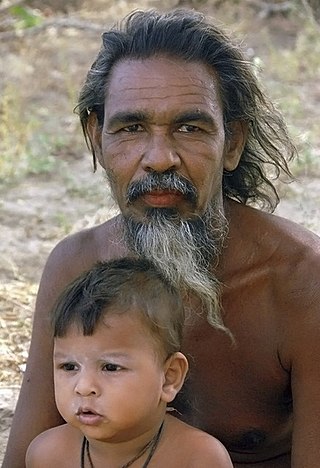
The Vedda, or Wanniyalaeto, are a minority indigenous group of people in Sri Lanka who, among other sub-communities such as Coast Veddas, Anuradhapura Veddas and Bintenne Veddas, are accorded indigenous status. The Vedda minority in Sri Lanka may become completely assimilated. Most speak Sinhala instead of their indigenous languages, which are nearing extinction. It has been hypothesized that the Vedda were probably the earliest inhabitants of Sri Lanka and have lived on the island since before the arrival of other ethnic groups in India.
Bogar, Bhogar, or Boganathar was a Tamil Shaivite Siddhar. He was a disciple of Kalangi Nathar. He was born in Vaigavur near Palani Hills. He received his education from his mother and his grand father described in several traditions and texts. Bogar himself describes his native roots in his book "Bogar 7000". Bogar went from Tamil Nadu to China and taught about enlightenment, this is also mentioned in his book Bogar 7000. Bogar is said to be in "nirvikalpa samadhi" below the sanctorum of Palani Murugan hill temple. The Tamraparniyan sea route was adopted by Bogar in his travels from South India to China via Sri Lanka.

Hinduism is one of Sri Lanka's oldest religions, with temples dating back over 2,000 years. As of 2011, Hindus made up 12.6% of the Sri Lankan population. They are almost exclusively Tamils, except for small immigrant communities from India and Pakistan.
Kuveni, also known as Sesapathi or Kuvanna or Leelawathi, was a Yakshini queen in Sri Lanka mentioned in the ancient Pali chronicles Mahavansa and Dipavansa of the Sinhalese people. The primary source for her life-story is the Mahavansa. She is venerated as Maha Loku Kiriammaleththo by the Veddas. Other names for her varying with Veddas habitats are Indigolle Kiriamma, Unapane Kiriamma, Kande Kiriamma, Divas Kiriamma, Wellasse Kiriamma, Kukulapola Kiriamma and Bili Kiriamma.
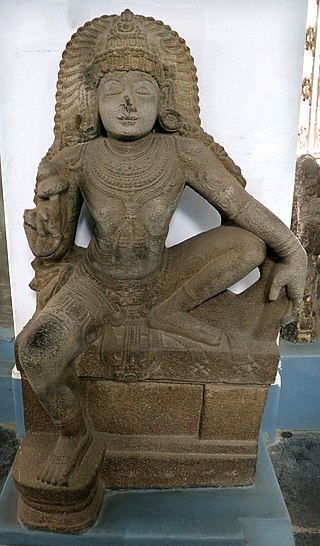
Ayyanar is a Tamil Hindu deity venerated in South India and Sri Lanka. His worship is prevalent amongst the rural Tamil people. Some studies suggest that Ayyanar may have also been worshipped in Southeast Asian countries in the past. He is primarily worshipped as one of the guardian folk deities of Tamil Nadu. The temples of Ayyanar in the countryside are usually flanked by gigantic and colourful statues of him and his companions riding horses or elephants.

Vaḷḷi is a Hindu goddess, and the second consort of the deity Murugan. An incarnation of the goddess Sundaravalli, daughter of Vishnu, Valli is born on earth as the daughter of a chieftain, leading a life of a huntress. Murugan, the god of war, eventually woos and weds her, according to Tamil folklore. Both of their legends originate from the mountain region also known as Kurunji in Tamilakam. Her sister, Amritavalli (Devasena), also succeeds in marrying Murugan as the adopted daughter of Indra, making them sister-wives.

The Swaminatha Swamy Temple is a Hindu temple dedicated to god Murugan. It is located in Swamimalai, 5 km from Kumbakonam, on the banks of a tributary of river Kaveri in Thanjavur District, 290 km from Chennai, the capital of Tamil Nadu, India. The temple is fourth abode of Murugan among six (Arupadaiveedugal). The shrine of the presiding deity, Swaminathaswamy is located atop a 60 ft (18 m) hillock and the shrine of his mother Meenakshi (Parvati) and father Shiva (Sundareswarar) is located downhill. The temple has three gopuram, three precincts and sixty steps and each one is named after the sixty Tamil years. The temple has six daily rituals at various times from 5:30 a.m. to 9 p.m., and three yearly festivals on its calendar. The annual Vaikasi Visagam festival is attended by thousands of devotees from far and near.

The Sinhala Hound is a landrace of dog from Sri Lanka.
Vedda is an endangered language that is used by the indigenous Vedda people of Sri Lanka. Additionally, communities such as Coast Veddas and Anuradhapura Veddas who do not strictly identify as Veddas also use words from the Vedda language in part for communication during hunting and/or for religious chants, throughout the island.
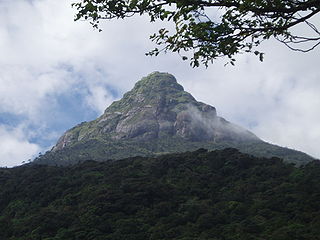
Adam's Peak is a 2,243 m (7,359 ft) tall conical sacred mountain located in central Sri Lanka. It is well known for the Sri Pada, a 1.8 m rock formation near the summit whose name is also used for the mountain itself. In Buddhist tradition the print is held to be the footprint of the Buddha, in Sri Lankan Hindu tradition that of Hanuman or Shiva and in some Islamic and Christian traditions that of Adam or St. Thomas.

The Coast Veddas, by self-designation, form a social group within the minority Sri Lankan Tamil ethnic group of the Eastern province of Sri Lanka. They are primarily found in small coastal villages from the eastern township of Trincomalee to Batticalao. Nevertheless, they also inhabit a few villages south of Batticalao as well. They make a living by fishing, slash and burn agriculture, paddy cultivation of rice, basket weaving for market and occasional wage labor. Anthropologists consider them to be partly descended from the indigenous Vedda people, as well as local Tamils. Residents of the Eastern province consider their Vedar neighbors to have been part of the local social structure from earliest times, whereas some Vedar elders believe that their ancestors may have migrated from the interior at some time in the past.

Upulvan, also known as Vishnu is a guardian deity of Sri Lanka. Sri Lankan Buddhists believe him also as a protector of the Buddhism in the country. The name Upulvan depicts his body colour which means "blue water lily coloured". The cult of Upulvan started during the medieval period in Sri Lanka. According to the local lore and legend, Upulvan is the god whom the Buddha entrusted with the guardianship of Sri Lanka and Buddha Śāsana of the country.

Maduru Oya National Park is a national park of Sri Lanka, established under the Mahaweli development project and also acts as a catchment of the Maduru Oya Reservoir. The park was designated on 9 November 1983. Providing a sanctuary to wildlife, especially for elephants and protecting the immediate catchments of five reservoirs are the importance of the park. A community of Vedda people, the indigenous ethnic group of Sri Lanka lives within the park boundary in Henanigala. The park is situated 288 kilometres (179 mi) north-east of Colombo.

Kataragama temple in Kataragama, Sri Lanka, is a temple complex dedicated to Buddhist guardian deity Kataragama deviyo and Hindu War God Murugan. It is one of the few religious sites in Sri Lanka that is venerated by the Buddhists, Hindus, Muslims and the Vedda people. For most of the past millennia, it was a jungle shrine very difficult to access; today it is accessible by an all-weather road. The shrines and the nearby Kiri Vehera are managed by Buddhists, the shrines dedicated to Teyvāṉai and Shiva are managed by Hindus and the mosque by Muslims.
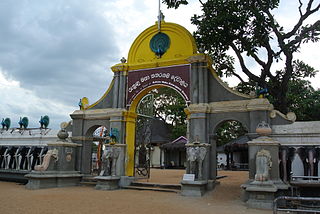
Kataragama is a pilgrimage town sacred to Hindu, Buddhist and indigenous Vedda people of Sri Lanka. People from South India also go there to worship. The town has the Kataragama temple, a shrine dedicated to Skanda Kumara also known as Kataragama deviyo. Kataragama is located in the Monaragala District of Uva province, Sri Lanka. It is 228 km (142 mi) southeast of Colombo. Although Kataragama was a small village in medieval times, today it is a fast-developing township surrounded by jungle in the southeastern region of Sri Lanka.
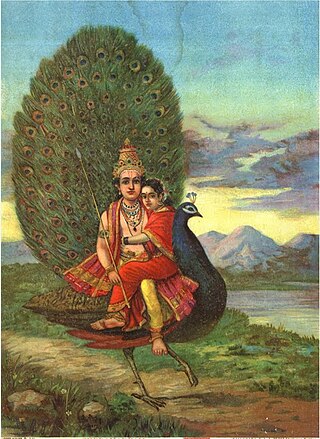
Devasena is a Hindu goddess of aspiration, and the consort of the war god Kartikeya (Murugan). She is also known as Devayanai, Deivanai, and Deivayanai in Tamil texts. Her name is also spelled as Teyvanai or Tevayanai.
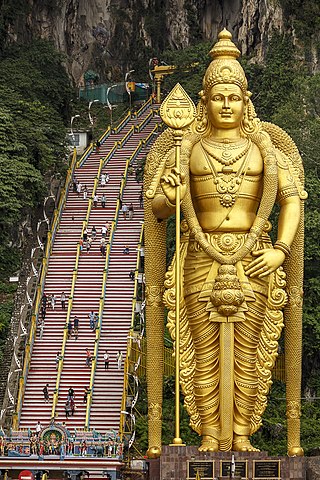
Kaumaram is a Hindu denomination that primarily venerates the Hindu deity of war, Kartikeya, also known as Kumaran, Murugan, Arumugan, and Subrahmanyan. Devotees of Kumaran, called Kaumaras, also revere members of his family: Parvati, Shiva, and Ganesha, as well his consorts, Devasena and Sundaravalli, the daughters of Vishnu in Tamil tradition. The important theological texts relating to Kumara are a part of the Shaiva agama canon. This sub-tradition is found among the Tamils, Kannadigas, and the Vedda, in South India, Sri Lanka, and among the Tamil diaspora worldwide. The love story of Kumara/Murugan and his wife Valli, a girl from a local tribe, is popular in Tamil Nadu, where Kumara acquired the status of a national god.

Kartikeya, also known as Skanda, Subrahmanya, Shanmukha and Murugan, is the Hindu god of war. He is the son of Shiva and Parvati and the brother of Ganesha.

The Pre-Anuradhapura period of Sri Lankan history begins with the gradual onset of historical records in the final centuries of the prehistoric period and ending in 437 BC. According to the Mahavamsa, the original inhabitants of Sri Lanka are the Yakshas and northern Naga tribes. Sinhalese history traditionally starts in 543 BC at the arrival of Prince Vijaya, a semi-legendary king who was banished from the Indian subcontinent with his 700 followers, and is recorded in the Mahavamsa chronicle. This period was succeeded by the Anuradhapura period.
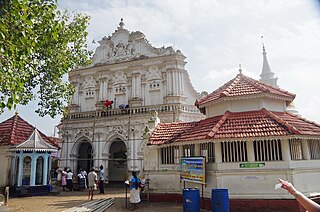
Kande Vihara is a major Buddhist temple in Kalutara District, Sri Lanka. The temple has got its name 'Kande vihara' as it is built on top of a hill located near to Aluthgama town. The temple has been formally recognised by the Government as an archaeological site in Sri Lanka.
References
- ↑ Holt, John (1999). Buddha in the crown: Avalokiteśvara in the Buddhist traditions of Sri Lanka. Oxford University Press. p. 242. ISBN 0-19-506418-6.
- ↑ Clothey, Fred; Ramanujan, A.K. (1978), The many faces of Murukan: the history and meaning of a South Indian god, Mouton de Gruyter, p. 39, ISBN 0-415-34438-7
- ↑ Clothey & Ramanujan 1978 , p. 38